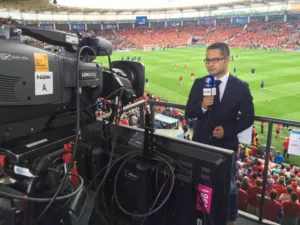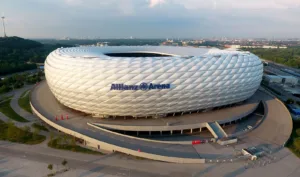The Modernization of the Global Football Industry: A Comprehensive Overview
The modernization of the global football industry has been a trend influenced by various factors such as globalization processes, technological advancements, and changes in fan preferences. The football industry has evolved from being a sport to a multibillion-dollar industry that has a significant economic impact on the global economy. The modernization of the football industry has led to the development of new technologies, which have transformed the way the game is played, managed, and experienced by fans.
Technological advancements have played a significant role in modernizing the global football industry. For instance, the use of video assistant referees (VAR) has revolutionized football by ensuring that referees make accurate decisions during matches. Additionally, the use of social media platforms has transformed the way football fans interact with their favorite teams and players. Stadiums have also been modernized to provide fans with a better viewing experience and to increase revenue for clubs.
The modernization of the global football industry has had a significant economic impact on the global economy. Football clubs and leagues generate billions of dollars in revenue annually, and this has contributed to the growth of the global economy. The globalization of football has also led to the growth of the industry in different regions of the world, including Asia and Africa.
Key Takeaways
- The modernization of the global football industry has been driven by various factors, including globalization processes and technological advancements.
- The use of new technologies, such as VAR and social media platforms, has transformed the way football is played, managed, and experienced by fans.
- The football industry has had a significant economic impact on the global economy, and the globalization of football has led to the growth of the industry in different regions of the world.
Evolution of Football Industry

Football has been a popular sport for centuries, and its popularity continues to grow with the modernization of the global football industry. The football industry has evolved from a simple sport to a complex business that generates billions of euros in revenue every year.
The evolution of the football industry can be traced back to the 19th century when football became a popular sport in Europe. Football clubs were established, and competitions began to emerge. The first international football match was played in 1872 between England and Scotland. The match was a huge success, and it paved the way for the development of international football competitions.
In the early 20th century, the football industry began to grow rapidly. The first football World Cup was held in 1930, and it was a huge success. The tournament attracted a large audience, and it generated a lot of revenue. The success of the tournament led to the establishment of other international football competitions, such as the European Championship and the Copa America.
The modernization of the global football industry began in the 1990s with the introduction of new technologies and the globalization of the sport. The introduction of new technologies, such as video technology and goal-line technology, has made the game fairer and more accurate. The globalization of the sport has led to the establishment of new football markets, such as Asia and the Middle East.
Today, the football industry is one of the largest and most profitable industries in the world. The industry generates billions of euros in revenue every year, and it employs millions of people worldwide. The modernization of the global football industry has led to the establishment of new football clubs, new competitions, and new technologies, making football more exciting and accessible than ever before.
Technological Advancements

The football industry has seen significant advancements in technology in recent years. These advancements have revolutionized the way the game is played, managed, and consumed. In this section, we will discuss some of the technological innovations that have had the most significant impact on the football industry.
Broadcasting Innovations
Broadcasting innovations have played a crucial role in modernizing the global football industry. The development of high-definition (HD) cameras and the introduction of slow-motion replays have allowed fans to see the game in greater detail than ever before. Broadcasting companies are now also experimenting with virtual reality (VR) and augmented reality (AR) technologies, which could revolutionize the way fans consume football.
Wearable Technology
Wearable technology has become increasingly popular in the football industry. Players now wear devices that can track their heart rate, distance covered, and other vital statistics. This technology allows coaches to monitor player performance and make data-driven decisions to improve their team’s performance. Wearable technology has also helped to reduce the risk of injury by allowing coaches to monitor players’ workload and prevent them from overexerting themselves.
Data Analytics and AI
Data analytics and artificial intelligence (AI) have become essential tools for football clubs. These technologies allow clubs to analyze vast amounts of data to gain insights into player performance, tactics, and other key areas. AI-powered tools can also help clubs to identify new talent and make data-driven decisions when it comes to buying and selling players.
In conclusion, technological advancements have had a significant impact on the football industry. Broadcasting innovations, wearable technology, and data analytics and AI have all played a crucial role in modernizing the game. As technology continues to evolve, we can expect to see even more innovations that will further revolutionize the way we play, manage, and consume football.
Economic Impact

Football is a multibillion-dollar industry that has a significant economic impact on countries and regions around the world. The modernization of the global football industry has led to an increase in club valuations, sponsorship and branding opportunities, and transfer market dynamics.
Club Valuations
According to a report by Forbes, the top 20 football clubs in the world are worth a combined $44.3 billion as of 2021. This is a 30% increase from the previous year, indicating the significant growth potential of football clubs. The increase in club valuations is due to several factors, including the growth of media rights deals, the expansion of the global fan base, and the emergence of new revenue streams.
Sponsorship and Branding
Sponsorship and branding opportunities have become a vital aspect of the modern football industry. Football clubs are no longer just sports teams but also powerful global brands that attract significant investment from multinational corporations. The sponsorship deals signed by football clubs have increased significantly over the years, with top clubs signing deals worth hundreds of millions of dollars.
Transfer Market Dynamics
The transfer market dynamics in the modern football industry have changed significantly. The transfer fees paid for top players have increased significantly, with some transfers costing hundreds of millions of dollars. The emergence of new markets, such as China and the Middle East, has led to an increase in demand for top players, leading to a rise in transfer fees.
In conclusion, the economic impact of the modernization of the global football industry cannot be overstated. The increase in club valuations, sponsorship and branding opportunities, and transfer market dynamics are just a few examples of the significant economic impact of football.
Globalization of Football

Football, also known as soccer, is the most popular sport in the world. In recent years, the football industry has undergone significant changes due to globalization. The globalization of football has led to the expansion of the sport into new markets and cross-cultural fan engagement.
Expansion into New Markets
The globalization of football has led to the expansion of the sport into new markets. Football clubs are now able to reach a global audience through the use of technology and social media. This has led to an increase in revenue for football clubs and has allowed them to invest in new players and infrastructure.
Football clubs are now expanding their markets by opening academies in different countries. This allows them to scout and develop young talent from around the world. In addition, football clubs are now playing pre-season games in different countries to increase their fan base and generate revenue.
Cross-Cultural Fan Engagement
The globalization of football has also led to cross-cultural fan engagement. Football fans from different countries are now able to connect with each other through social media and online forums. This has led to the creation of global fan communities and has increased the popularity of the sport.
Football clubs are now also engaging with fans in different countries by organizing fan events and meet and greets. This has allowed fans to connect with their favorite players and has increased their loyalty to the club.
In conclusion, the globalization of football has led to the expansion of the sport into new markets and cross-cultural fan engagement. Football clubs are now able to reach a global audience and increase their revenue through the use of technology and social media. The globalization of football has also allowed fans from different countries to connect with each other and has increased the popularity of the sport.
Stadium Modernization

Allianz Arena Stadium in Munich, Bavaria, Germany(Home of FC Bayern Munich)
The modernization of stadiums has been a key focus of the global football industry in recent years. With the rise of technology, stadiums are being transformed into smart, sustainable and efficient venues that enhance the overall fan experience. This section will explore the latest trends in stadium modernization, including smart stadiums and sustainability initiatives.
Smart Stadiums
Smart stadiums are equipped with cutting-edge technology that enhances the fan experience and improves operational efficiency. These stadiums use data analytics, IoT sensors, and mobile apps to provide fans with real-time information on everything from parking availability to concession lines. They also offer personalized experiences, such as customized seat recommendations and in-seat ordering.
One example of a smart stadium is the Mercedes-Benz Stadium in Atlanta, Georgia. This stadium features a unique retractable roof, a 360-degree halo video board, and an app that allows fans to order food and drinks from their seats. The stadium also uses a rainwater harvesting system to reduce water consumption and has a LEED Platinum certification for its sustainability efforts.
Sustainability Initiatives
Sustainability has become a top priority for the global football industry, and stadiums are no exception. Many stadiums are implementing green initiatives to reduce their carbon footprint and promote environmental responsibility. These initiatives include using renewable energy sources, reducing water usage, and implementing waste reduction programs.
One example of a sustainable stadium is the Johan Cruijff Arena in Amsterdam, Netherlands. This stadium has installed 4,200 solar panels on its roof, which generate enough energy to power 300 households. The stadium also uses a rainwater harvesting system to irrigate the field and has implemented a waste separation program that diverts 90% of its waste from landfills.
Overall, stadium modernization is transforming the global football industry. Smart stadiums and sustainability initiatives are enhancing the fan experience while promoting environmental responsibility. As technology continues to advance, we can expect to see even more innovative solutions that improve the overall stadium experience.
Regulatory Changes
The global football industry has undergone significant regulatory changes in recent years. These changes have been driven by a desire to improve the transparency and fairness of the sport, as well as to address issues such as financial impropriety and improper ownership structures.
Financial Fair Play
One of the most significant regulatory changes in recent years has been the introduction of Financial Fair Play (FFP) regulations. These regulations were introduced by UEFA in 2011 and require clubs to balance their books and operate within their means. The aim of FFP is to prevent clubs from spending beyond their means and to promote financial stability across the sport.
Under FFP, clubs are required to submit annual financial reports to UEFA, which are then reviewed by an independent panel. Clubs that fail to comply with FFP regulations can be subject to fines, transfer bans, or even exclusion from UEFA competitions.
Ownership Rules
Another area of regulatory change in the global football industry has been the introduction of new ownership rules. In recent years, there has been growing concern about the influence of wealthy individuals and corporations on football clubs, and the potential for these owners to use their clubs for personal gain.
To address these concerns, many football associations and governing bodies have introduced new ownership rules. These rules typically require club owners to be of good character, to have no criminal record, and to provide evidence of their financial stability and ability to fund the club.
Overall, these regulatory changes have been welcomed by many within the football industry. While there have been some concerns about the impact of FFP on smaller clubs, most agree that the changes have been necessary to promote transparency, fairness, and financial stability across the sport.
Fan Experience Enhancements

Tottenham Hotspur Stadium
Football clubs worldwide are investing in enhancing the fan experience to attract and retain supporters. With the advent of technology, digital engagement and matchday innovations have become the focal points for clubs to improve the overall fan experience.
Digital Engagement
Football clubs have recognized the importance of digital engagement in today’s world. Social media platforms such as Facebook, Twitter, and Instagram have become the primary means of communication between clubs and their fans. Clubs use these platforms to provide exclusive content, such as behind-the-scenes footage, interviews, and match highlights, to their fans. They also use these platforms to interact with their fans, answer their queries, and provide them with the latest updates.
In addition to social media, clubs are investing in mobile applications to provide personalized experiences to their fans. These applications offer features such as live match streaming, ticket purchasing, and merchandise shopping. Some clubs are also using augmented reality and virtual reality to provide immersive experiences to their fans.
Matchday Innovations
Matchday innovations have become a significant aspect of enhancing the fan experience. Clubs are investing in technology to provide fans with a seamless and enjoyable matchday experience. For instance, some clubs are using facial recognition technology to enable fast and secure entry into stadiums. Others are using cashless payment systems to reduce queues and provide a hassle-free experience to their fans.
Moreover, clubs are using data analytics to gain insights into their fans’ preferences and habits. They use this information to tailor the matchday experience to their fans’ specific persona. For instance, some clubs provide exclusive access to their VIP lounges to their high-spending fans.
In conclusion, football clubs worldwide are investing in digital engagement and matchday innovations to enhance the fan experience. With the use of technology, clubs can provide personalized experiences to their fans, making them feel valued and appreciated. These enhancements not only attract new fans but also retain existing ones, making football a more enjoyable and exciting sport to follow.
Youth Development and Academies

La Masia Academy
The development of young football players has become an increasingly important aspect of the global football industry. Many clubs and organizations have established academies to provide young players with the training and support they need to reach their full potential.
One of the key benefits of youth development programs is that they allow clubs to identify and nurture talented young players at an early age. This can help to ensure that the club has a steady supply of talented players for the future. In addition, youth development programs can help to create a sense of loyalty and commitment among young players, who may be more likely to remain with the club as they progress through their careers.
Academies typically provide young players with a structured training program that focuses on developing their technical, tactical, physical, and mental skills. This may include regular training sessions, matches against other academies, and access to top-level coaching and support staff.
Some academies also place a strong emphasis on academic and personal development, recognizing that young players need to develop a range of skills and qualities in order to succeed both on and off the field. For example, many academies provide their players with access to academic tutors, career guidance, and other support services.
Overall, the rise of youth development and academies has been a positive development for the global football industry. By investing in the development of young players, clubs and organizations can help to ensure the long-term success of the sport, while also providing young people with opportunities to grow and succeed.
Women’s Football Growth

The growth of women’s football has been remarkable in recent years. According to a FIFA survey report, the number of women and girls playing organized football has increased by nearly a quarter compared to 2019, reaching 16.6 million. Additionally, 88% of member associations surveyed have a women’s football strategy, and 67% have a safeguarding policy.
UEFA has been a driving force behind the growth of women’s football. The Women’s Champions League has experienced incredible growth in recent years due in part to a strategy put in place by UEFA five years ago. The strategy will be renewed ahead of the final, according to UEFA.
Furthermore, the introduction of new events and tournaments has been a part of the vision for women’s football growth. The FIFA Vision 2020-2023 outlines a goal to reform the women’s competition system with the introduction of new events, encompassing both senior and youth tournaments. Strategies to achieve the optimal number and frequency of competitions are currently under consideration with the objective of enabling women’s football to grow at an exponential rate, according to FIFA.
Women’s football has also seen growth in commercialization. The International Sports Convention hosted a panel on the “Growth, Development, Commercialisation and Challenges in Women’s Football,” which featured various industry experts. Among them was Sarah Gregorius, Director of Global Policy & Strategic Relations Women’s Football at FIFPro, who emphasized the importance of commercialization in the growth of women’s football.
In conclusion, women’s football has been experiencing remarkable growth in recent years. The introduction of new events and tournaments, along with strategies to achieve the optimal number and frequency of competitions, has been a part of the vision for women’s football growth. The growth of women’s football has also been driven by commercialization and the efforts of organizations such as UEFA and FIFA.
Frequently Asked Questions
How has technology influenced the evolution of the football industry?
Technology has played a significant role in the evolution of the football industry. The use of VAR (video assistant referee) technology has helped referees make more accurate decisions during games. Additionally, the development of wearable technology has allowed teams to track player performance and prevent injuries. The use of social media and digital platforms has also revolutionized the way fans engage with the sport.
What are the key factors driving the growth of the global football market?
The growth of the global football market can be attributed to several factors. The increasing popularity of the sport worldwide has led to a rise in demand for football-related products and services. The growth of the middle class in emerging economies has also contributed to the expansion of the market. Furthermore, the increasing use of technology in the sport has opened up new revenue streams for clubs and leagues.
In what ways has globalization impacted the competitive landscape of football?
Globalization has had a significant impact on the competitive landscape of football. The increasing mobility of players has led to a more diverse pool of talent, with teams from around the world competing for the best players. The globalization of media has also led to a more global audience for the sport, with fans from different parts of the world following their favorite teams and players.
What are the economic implications of the football industry on global markets?
The football industry has significant economic implications on global markets. The industry generates billions of dollars in revenue each year, creating jobs and driving economic growth. The industry also has a significant impact on the tourism industry, with fans traveling to different countries to watch games and support their teams.
How have fan engagement strategies evolved in modern football?
Fan engagement strategies have evolved significantly in modern football. The use of social media and digital platforms has allowed clubs and leagues to engage with fans in new and innovative ways. Clubs have also invested in creating unique fan experiences, such as fan zones and interactive exhibits.
What role does the NFL’s Global Markets Program play in the expansion of football worldwide?
The NFL’s Global Markets Program plays a significant role in the expansion of football worldwide. The program aims to introduce American football to new markets around the world, with a focus on countries such as China and Mexico. The program includes initiatives such as coaching clinics, player visits, and fan events, all of which help to promote the sport and build a fan base in new markets.
More Articles:
Also See: The Usage of VAR Technologies in Football: A Comprehensive Overview
Also See: The Problem of Racism in Brazilian Football: A Clear Overview
Also See: Kings of Diving in Football History: A Look at the Most Notorious Players
Tags: Economic Impact, Evolution of Football Industry, Fan Experience Enhancements, Globalization of Football, Regulatory Changes, Stadium Modernization, Technological Advancements in Football Industry, Women's Football Growth, Youth Development and Academies